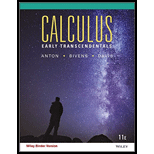
Suppose that the acceleration function of a particle moving along an
Want to see the full answer?
Check out a sample textbook solution
Chapter 5 Solutions
Calculus Early Transcendentals, Binder Ready Version
Additional Math Textbook Solutions
Precalculus Enhanced with Graphing Utilities
Calculus 2012 Student Edition (by Finney/Demana/Waits/Kennedy)
University Calculus: Early Transcendentals (3rd Edition)
Calculus: Early Transcendentals (2nd Edition)
- Algebra & Trigonometry with Analytic GeometryAlgebraISBN:9781133382119Author:SwokowskiPublisher:Cengage
